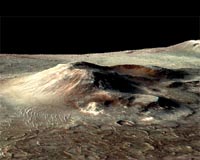 |
Tucson AZ (SPX) Nov 23, 2010 An international research team led by the Planetary Science Institute has found evidence for reservoirs of liquid water on Mars at shallow crustal depths of as little as tens of meters. J. Alexis Palmero Rodriguez, research scientist at PSI, and the research team came to this conclusion after studying collapsed terrains that occur within some of the solar system's largest channels. Investigations of similar but vastly larger zones of collapse located where these channels initiate have led previous investigations to postulate that the upper crust of Mars contained vast aquifer systems concealed underneath a global frozen layer kilometers in thickness. However, these zones of large-scale collapse are rare on Mars and their formation most likely took place under exceptional hydrogeologic conditions. The PSI-led team's work documents the distribution of groundwater within crustal zones located beyond these regions. Citing geologic evidence found in the planet's largest system of channels located in southern circum-Chryse and results from thermal numerical modeling, Rodriguez and his co-authors propose in an article published in Icarus that groundwater reservoirs may have been common within the Martian upper crust. The numerical model implies that where fine-grained, unconsolidated sedimentary deposits existed on top of an icy permafrost layer, melting of ground ice and the development of subsurface aquifers could have taken place at shallow depths. Extrapolations of their results to the present Martian conditions imply that groundwater may currently exist underneath thermally insulating fine-grained sedimentary deposits approximately 120 meters in thickness. Thus, despite large differences in hydrogeologic histories, average surface temperatures, and internal heat flows of Earth and Mars, some areas of Mars might be similar to typical permafrost on Earth, where shallow aquifers are confined by thin layers of icy permafrost. These reservoirs could mean the presence of accessible water near the Martian surface, Rodriguez said, which could greatly reduce the costs of future manned exploration of the planet. In addition, it could mean habitable environments may exist at shallow depths, he said. This research was funded by a grant to PSI from the NASA Mars Data Analysis Program. Rodriguez is lead author on the paper. Co-authors are: Jeffrey S. Kargel, Department of Hydrology and Water Resources, University of Arizona; Kenneth L. Tanaka, Astrogeology Science Center, U.S. Geological Survey; David A. Crown, Planetary Science Institute; Daniel C. Berman, Planetary Science Institute; Alberto G. Fairen, SETI Institute and Space Science and Astrobiology Division, NASA Ames Research Center; Victor R. Baker, Department of Hydrology and Water Resources, University of Arizona; Roberto Furfaro, Department of Aerospace and Mechanical Engineering, University of Arizona; Pat Candelaria, Department of Aerospace and Mechanical Engineering, University of Arizona and Sho Sasaki, National Astronomical Observatory of Japan.
Share This Article With Planet Earth
Related Links Planetary Science Institute Mars News and Information at MarsDaily.com Lunar Dreams and more
 Mars Volcanic Deposit Tells Of Warm And Wet Environment
Mars Volcanic Deposit Tells Of Warm And Wet EnvironmentProvidence RI (SPX) Nov 02, 2010 Roughly 3.5 billion years ago, the first epoch on Mars ended. The climate on the red planet then shifted dramatically from a relatively warm, wet period to one that was arid and cold. Yet there was at least one outpost that scientists think bucked the trend. A team led by planetary geologists at Brown University has discovered mounds of a mineral deposited on a volcanic cone less than 3.5 ... read more |
|
| The content herein, unless otherwise known to be public domain, are Copyright 1995-2010 - SpaceDaily. AFP and UPI Wire Stories are copyright Agence France-Presse and United Press International. ESA Portal Reports are copyright European Space Agency. All NASA sourced material is public domain. Additional copyrights may apply in whole or part to other bona fide parties. Advertising does not imply endorsement,agreement or approval of any opinions, statements or information provided by SpaceDaily on any Web page published or hosted by SpaceDaily. Privacy Statement |